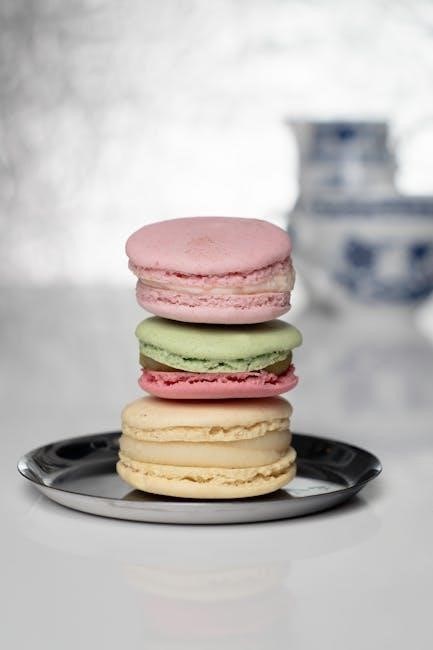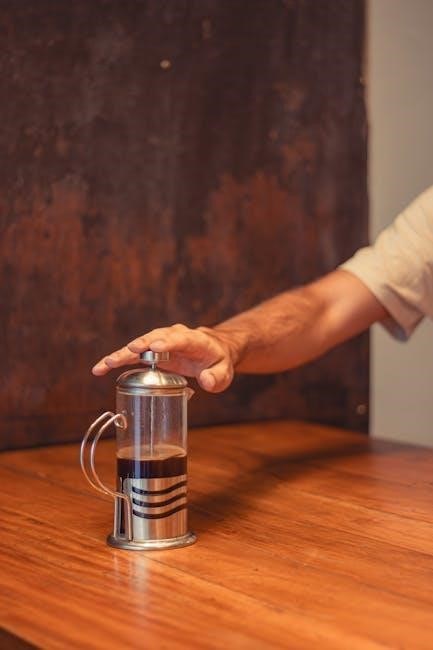French press coffee offers a rich‚ bold flavor and a straightforward brewing process․ Known for its simplicity‚ it requires only coffee grounds‚ hot water‚ and a press․
It’s a favorite among coffee enthusiasts due to its affordability and ease of use‚ delivering a full-bodied cup with minimal equipment․
Discover how this traditional method brings out the best in your coffee beans‚ making it a timeless choice for both beginners and coffee connoisseurs alike․
What is French Press Coffee?
French press coffee‚ also known as cafetière or coffee press‚ is a traditional brewing method that involves steeping coarse coffee grounds in hot water and then pressing them to separate the liquid․ This technique allows the coffee grounds to remain in contact with the water throughout the brewing process‚ resulting in a bold‚ rich‚ and full-bodied flavor․ The French press is known for its simplicity and ability to extract more oils and sediment from the coffee beans compared to other brewing methods‚ giving it a distinctively robust taste․ It’s a popular choice among coffee enthusiasts due to its cost-effectiveness‚ ease of use‚ and the high-quality coffee it produces․
History of French Press Brewing
The French press‚ also known as a cafetière or coffee press‚ has a long and evolving history that dates back to the mid-19th century․ The first known prototype was patented in 1852 by two Frenchmen‚ Mayer and Delforge‚ who developed a device with a plunger and a metal filter․ Over the years‚ the design underwent significant improvements‚ particularly in the 1920s when an Italian designer named Attilio Calimani introduced a more practical version with a spring-loaded filter․ The modern French press gained popularity in the 1950s and has since become a staple in coffee culture worldwide‚ cherished for its simplicity and ability to produce a rich‚ full-bodied coffee․ Its enduring appeal lies in its timeless design and the quality of coffee it consistently delivers․
Why Choose French Press?
French press coffee stands out for its simplicity and affordability‚ making it an excellent choice for coffee lovers of all levels․ It requires no special equipment‚ delivering a rich‚ bold flavor that many find superior to other brewing methods․
The French press allows for full immersion of coffee grounds in water‚ ensuring a deeper extraction of flavors and oils․ This method offers unparalleled control over brewing parameters‚ making it ideal for those who enjoy experimenting with coffee-to-water ratios and steeping times․
Additionally‚ it’s eco-friendly and cost-effective‚ as it eliminates the need for paper filters or expensive machines․ The French press is also portable and easy to clean‚ making it a versatile option for home‚ travel‚ or outdoor use․
For coffee enthusiasts seeking a hands-on‚ customizable brewing experience‚ the French press is a timeless and rewarding choice that enhances the sensory enjoyment of coffee․
Choosing the Right French Press
Selecting the right French press involves considering durability‚ size‚ and key features․ Opt for sturdy materials‚ appropriate capacity‚ and user-friendly designs to enhance your brewing experience․
Materials: Glass vs․ Metal vs․ Ceramic
When choosing a French press‚ the material is crucial for both durability and flavor; Glass French presses are non-reactive and allow you to visually monitor the brewing process‚ ensuring transparency and purity of taste․ Metal options‚ often made of stainless steel‚ are highly durable‚ easy to clean‚ and retain heat exceptionally well‚ making them ideal for consistent brewing․ Ceramic French presses‚ while heavier‚ also offer excellent heat retention and a non-reactive surface‚ preserving the coffee’s natural flavors․ Each material has its benefits‚ so consider factors like durability‚ heat retention‚ and aesthetic preferences when selecting the perfect French press for your needs․ Your choice will significantly impact your brewing experience and the flavor profile of your coffee․
Size and Capacity Options
French presses come in various sizes to suit different needs‚ ranging from single-serve models to larger options for multiple cups․ Common sizes include 4 cups (1 liter)‚ 6 cups (1․5 liters)‚ and 8 cups (1․8 liters)‚ with some models offering up to 12 cups for entertaining․ Single-serve French presses are ideal for personal use‚ while larger ones are perfect for sharing or for households that consume more coffee․ The size you choose should align with your lifestyle and the number of people you’re brewing for․ A smaller French press is great for precision and control‚ while a larger one ensures everyone can enjoy a fresh cup simultaneously․ Selecting the right size ensures optimal flavor and convenience‚ making every brewing experience enjoyable and stress-free․
Key Features to Look For
When selecting a French press‚ consider key features that enhance durability and brewing performance․ Look for a sturdy‚ well-constructed design with a smooth‚ even plunger mechanism to ensure consistent extraction․ The material of the carafe—glass‚ stainless steel‚ or ceramic—affects heat retention and durability․ A secure handle and tight-fitting lid are essential for safe pouring and minimizing spills․ Some models include a built-in grinder or measuring marks for convenience․ Opt for a press with a coarse grind size capability to avoid silt in your coffee․ Quality components‚ such as a metal or nylon mesh filter‚ ensure better flavor extraction․ Prioritize models with easy cleaning and dishwasher-safe parts for maintenance․ A well-designed French press will deliver a superior brewing experience and last for years with proper care․
Preparing for Brewing
Preparing for brewing involves selecting quality coffee beans‚ grinding them to the right size‚ and ensuring optimal water quality and temperature for the best flavor extraction․
Coffee Bean Selection
Selecting the right coffee beans is crucial for a perfect French Press․ Choose freshly roasted‚ high-quality beans to ensure optimal flavor and aroma․ Arabica beans are generally preferred for their nuanced taste‚ while Robusta offers a bolder‚ more bitter profile․ Lighter roasts provide brighter acidity and fruity notes‚ while darker roasts deliver deeper‚ richer flavors․ For the best experience‚ opt for whole beans and grind them immediately before brewing to preserve freshness․ Store beans in an airtight container in a cool‚ dark place to maintain their quality․ Experiment with different origins and blends to find your ideal match for French Press brewing․
Grinding the Beans: The Right Grind Size
The grind size of your coffee beans is essential for French Press brewing․ Aim for a coarse grind‚ similar to breadcrumbs‚ to ensure optimal extraction․ A grind that’s too fine can lead to a bitter taste and silt in your coffee‚ while a grind that’s too coarse may result in a weak or under-extracted brew․ Use a burr grinder for consistent results‚ as blade grinders can create uneven particles․ Adjust the grind size based on your personal preference and the specific beans you’re using․ Proper grinding ensures a balanced flavor and aroma‚ making it a critical step in achieving the perfect French Press coffee․ Experiment to find the grind that works best for you․
Water Quality and Temperature
Water quality and temperature are crucial for brewing French Press coffee․ Use fresh‚ filtered water to avoid any impurities or off-flavors․ Chlorinated water can negatively impact the taste‚ so consider using a water filter․ The ideal brewing temperature is between 195°F and 205°F‚ as this range extracts the optimal amount of flavor and oils from the coffee beans․ Avoid using boiling water‚ as it can burn the coffee and result in a bitter taste․ Let the water cool slightly after boiling before pouring it over the grounds․ Proper temperature control ensures a balanced extraction‚ bringing out the full aroma and flavor of your coffee․ This step is essential for achieving a perfect cup of French Press coffee․
Brewing Techniques
Brewing French press involves adding coarse grounds‚ pouring hot water‚ and steeping․ Stir gently‚ let sit‚ then press slowly for a balanced extraction and rich flavor․
Step-by-Step Brewing Guide
Start by heating water to around 200°F and measuring your coffee—typically 1 tablespoon per 6 ounces of water․ Grind the beans to a coarse texture․
Add the grounds to the French press‚ pour the hot water evenly‚ and stir gently to saturate all grounds․ Allow the mixture to steep for 3-4 minutes․
After steeping‚ slowly press the plunger down to separate the grounds from the liquid․ Pour the coffee immediately to prevent over-extraction and enjoy your perfectly brewed cup․
Importance of Water-to-Coffee Ratio
The water-to-coffee ratio is crucial for achieving a balanced flavor in French press coffee․ A general rule is 1 tablespoon of coffee for every 6 ounces of water‚ translating to a 1:15 to 1:17 ratio for larger batches․
If the ratio is too high‚ the coffee may taste weak; too low‚ and it becomes bitter․ Adjusting this ratio allows you to tailor the strength to your preference without compromising flavor quality․
- Too much water dilutes the coffee‚ losing richness․
- Too little water results in over-extraction and bitterness․
Experimenting with the ratio ensures a perfect cup every time‚ making it a foundational element of the French press method․
Steeping Time: How Long to Brew
The steeping time for French press coffee is a critical factor in achieving the perfect cup․ The ideal brewing time is typically between 3 to 4 minutes‚ allowing the coffee grounds to fully infuse with the water․
A 3-minute steep results in a brighter‚ smoother flavor‚ while 4 minutes produces a bolder‚ richer taste․ Over-steeping can lead to bitterness‚ while under-steeping may result in a weak or underdeveloped flavor․
- Start timing after adding water to the French press․
- Allow the coffee to “bloom” for 30 seconds before stirring․
- Adjust the steeping time based on personal preference for strength and flavor profile․
Mastering the steeping time ensures a balanced extraction‚ making it a key step in the French press brewing process․
Tips for the Perfect Cup
Use coarse grinds‚ preheat your French press‚ and brew for 3-4 minutes․ Ensure water is at 195°F for optimal extraction․ Stir gently after blooming for even flavor․
Common Mistakes to Avoid
When brewing French press coffee‚ several common mistakes can affect the final result․ One of the most frequent errors is using the wrong grind size—too fine can lead to over-extraction and a gritty texture‚ while too coarse may result in under-extraction and a weak flavor․ Another mistake is not preheating the French press‚ which can cause inconsistent extraction․ Additionally‚ steeping the coffee for too long or too short a time can ruin the balance․ Lastly‚ pressing the plunger too aggressively can stir up sediment‚ making the coffee bitter or cloudy․ Avoiding these mistakes ensures a smoother‚ more flavorful cup every time․
Troubleshooting: Fixing Bitter or Weak Coffee
Troubleshooting: Fixing Bitter or Weak Coffee
If your French press coffee tastes bitter‚ it may be due to over-extraction‚ often caused by a fine grind‚ over-steeping‚ or water that’s too hot․ To fix this‚ try a coarser grind‚ reduce steeping time‚ or lower the water temperature․ On the other hand‚ weak coffee typically results from under-extraction‚ which can occur with a too-coarse grind‚ under-steeping‚ or insufficient coffee․ Adjust by using a finer grind‚ extending the steeping time‚ or adding a bit more coffee․ Balancing these elements ensures a flavorful cup․ Small adjustments can make a significant difference‚ so experiment to find your perfect brew․
Storing Coffee Beans for Optimal Flavor
To preserve the flavor of your coffee beans‚ store them in an airtight container to prevent air exposure‚ which can lead to staleness․ Glass or ceramic containers are ideal as they don’t impart flavors like some plastics can․ Keep the container in a dark place‚ such as a pantry‚ away from direct sunlight and heat sources like ovens․ Freezing is a good option for long-term storage‚ but ensure you use airtight‚ moisture-proof containers to maintain freshness․ For daily use‚ store a small portion in an airtight container․ Buy beans in smaller quantities to use them before they lose flavor․ Grind just before brewing to ensure maximum flavor․ Consider using containers with one-way valves to release gases without admitting air․ Avoid storing beans near strong-smelling foods to prevent odor transfer․ By following these guidelines‚ you can enjoy fresh‚ flavorful French press coffee․

Serving and Enjoying
Serve French press coffee immediately after brewing for optimal flavor․ Use preheated cups to maintain temperature․ Pair with pastries‚ chocolate‚ or breakfast dishes for a delightful experience․
How to Serve French Press Coffee
Serving French press coffee is an art that enhances the overall experience․ Start by pouring the coffee immediately after brewing to preserve its bold‚ rich flavors․ Use preheated cups to maintain the ideal temperature‚ as this prevents the coffee from cooling down too quickly․ For a traditional touch‚ serve alongside a variety of sweet or savory accompaniments‚ such as croissants‚ muffins‚ or even dark chocolate․ Experiment with milk‚ cream‚ or sugar to suit your taste preferences․ The versatility of French press allows it to be enjoyed black or customized to your liking‚ making it perfect for any occasion․
Pairing Coffee with Food
Pairing French press coffee with food enhances its rich‚ bold flavors․ Sweet pastries like croissants or muffins balance the coffee’s bitterness‚ while savory options like eggs or cheese provide a delightful contrast․ Dark chocolate complements the coffee’s deep notes‚ creating a luxurious treat․ Nuts‚ such as almonds or hazelnuts‚ add a satisfying crunch and flavor contrast․ For a hearty pairing‚ try serving with breakfast dishes or grilled meats․ The versatility of French press allows it to pair well with both sweet and savory options‚ making it a perfect companion for any meal․ Experiment with different combinations to find your ideal match and elevate your coffee experience․

Cleaning and Maintenance
Regularly rinse the French press with warm water after use and dry thoroughly to prevent bacteria growth․ Avoid harsh chemicals to maintain the coffee’s pure taste․ Perform deep cleans periodically to remove residual oils and ensure optimal brewing performance․ Proper maintenance extends the lifespan of your French press and keeps your coffee flavorful․
How to Clean Your French Press
Cleaning your French press is essential to maintain its performance and prevent residual coffee oils from affecting the taste of future brews․ After each use‚ rinse the press thoroughly with warm water to remove loose coffee grounds and residue․ For deeper cleaning‚ mix mild dish soap with warm water‚ scrub all parts gently‚ then rinse thoroughly․ Avoid using harsh chemicals or abrasive cleaners‚ as they may damage the materials or leave unwanted flavors․ Dry the French press completely after cleaning to prevent bacterial growth․ For stubborn stains‚ soak the components in warm soapy water before scrubbing․ Regular cleaning ensures your French press remains in great condition and continues to brew delicious coffee․
Maintaining Your French Press
Regular maintenance ensures your French press continues to perform optimally․ For glass‚ metal‚ or ceramic models‚ rinse thoroughly after use and dry to prevent bacterial growth․ Avoid using abrasive cleaners‚ as they may damage surfaces․ For tough residue‚ soak in warm‚ soapy water before scrubbing gently․ Descale periodically if using hard water to remove mineral buildup․ Check the plunger and seal for wear and tear‚ replacing them if necessary․ Store your French press in a dry place to maintain its longevity․ Proper care ensures consistent brewing results and keeps your French press in excellent condition for years to come․

Advanced Techniques
Explore beyond the basics with techniques like pre-bloom phases and steeping time variations․ Adjust grind size and water temperature for unique flavor profiles‚ enhancing your French press experience;
Customizing Flavor Profiles
Customizing flavor profiles in French press coffee allows you to tailor your brew to your taste preferences․ By adjusting variables such as grind size‚ steeping time‚ and water temperature‚ you can bring out different nuances in your coffee․ For instance‚ a finer grind can result in a bolder‚ more intense flavor‚ while a coarser grind may yield a smoother cup․ Experimenting with these elements enables you to explore a wide range of flavor possibilities‚ from bright and acidic to rich and full-bodied․ This level of control makes French press brewing both versatile and rewarding for coffee enthusiasts seeking a personalized experience․
Using Different Coffee Roasts
Experimenting with various coffee roasts can elevate your French press experience․ Lighter roasts‚ with their bright acidity and fruity notes‚ offer a vibrant and refreshing taste․ Medium roasts provide a balanced flavor‚ combining acidity with hints of chocolate and nuts․ Dark roasts bring bold‚ rich flavors with deep chocolatey and smoky undertones․ Each roast level interacts differently with the French press method‚ as the immersion brewing process extracts more oils and solids․ To find your perfect match‚ try different roasts and adjust brewing parameters like steeping time and grind size․ This exploration allows you to discover how each roast’s unique characteristics shine through in your cup‚ ensuring a tailored flavor experience every time․
Health Considerations
French press coffee contains higher caffeine levels due to the immersion brewing method․ It also retains more coffee oils‚ offering antioxidants and potential health benefits like improved heart health and cognitive function․ Moderate consumption is recommended to avoid excessive caffeine intake․
Caffeine Content in French Press Coffee
French press coffee generally has a higher caffeine content compared to other brewing methods due to the immersion process‚ which allows more coffee oils and caffeine to extract into the liquid․ On average‚ an 8oz cup of French press coffee can contain between 100-200mg of caffeine‚ depending on factors like coffee bean type‚ roast level‚ and grind size․ The longer steeping time and lack of a paper filter‚ which absorbs some caffeine‚ contribute to this higher concentration․ For those sensitive to caffeine‚ adjusting the coffee-to-water ratio or steeping time can help moderate the intensity․ Moderate consumption is recommended to avoid potential side effects․
Health Benefits of French Press Coffee
French press coffee offers several health benefits when consumed in moderation․ The immersion brewing method retains more coffee oils and antioxidants compared to filtered coffee‚ which may provide additional health advantages․ Antioxidants in coffee can help protect against oxidative stress and inflammation‚ potentially reducing the risk of chronic diseases like heart disease and diabetes․ Caffeine in French press coffee can also improve alertness‚ focus‚ and physical performance․ Additionally‚ moderate coffee consumption has been linked to a lower risk of certain neurological conditions‚ such as Parkinson’s disease and Alzheimer’s․ However‚ individual responses to caffeine vary‚ so it’s important to balance consumption based on personal tolerance and health guidelines․

Accessories and Tools
Essential accessories include a burr grinder for consistent grinds‚ coffee scales for precise measurements‚ and a gooseneck kettle for controlled water pouring‚ enhancing your brewing experience․
Best Grinders for French Press
A good grinder is crucial for achieving the perfect French press coffee․ Burr grinders are highly recommended as they produce a consistent‚ coarse grind without generating heat‚ which can damage the beans․ Blade grinders‚ while cheaper‚ are less precise and can lead to uneven extraction․ Look for a burr grinder with adjustable settings to tailor the grind size to your French press needs․ Manual burr grinders are cost-effective and easy to clean‚ while electric burr grinders offer convenience and speed․ Invest in a high-quality grinder to ensure optimal flavor and aroma in every brew․ Consistency in grind size is key to avoiding silt and bitterness in your coffee․
Recommended Coffee Scales
Coffee scales are essential for precise measurements‚ ensuring the perfect water-to-coffee ratio․ Digital scales are highly recommended for their accuracy and ease of use‚ allowing you to measure both coffee and water with precision․ Look for a scale with a high weight capacity and a clear‚ easy-to-read display․ Some models come with timers‚ which can be helpful for monitoring steeping time․ Manual scales are also available for those who prefer a more traditional approach․ When choosing a scale‚ consider durability‚ ease of cleaning‚ and portability․ A good scale will help you achieve consistency in your brew‚ making it a worthwhile investment for any French press enthusiast․
Other Essential Accessories
Beyond the basics‚ several accessories can enhance your French press experience․ A burr grinder ensures freshly ground beans for optimal flavor․ A gooseneck kettle provides precise water control‚ while a coffee scoop helps measure accurately․ Coffee storage containers maintain bean freshness‚ and a milk frother adds versatility for creamy drinks․ Filters‚ though not required‚ can reduce sediment for a cleaner cup․ A thermometer ensures water temperature is ideal‚ and a cleaning brush keeps your French press in top shape․ These tools collectively elevate the brewing process‚ offering consistency and customization for a perfect cup every time․
